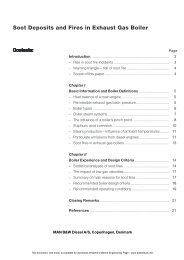Where the Actionin <strong>Fuel</strong> <strong>Cells</strong> is TodayAllied SignalVolvoBallardDaimlerChryslerDetroit EdisonDuPontShellFordGeneral MotorsHondaMazdaGeorgetown UniversityCase Western Reserve UniversityLos Alamos National LaboratoryMotorolaPenn State UniversityPrinceton UniversityRolls-RoyceArgonne National LaboratorySanyoDAISSiemensBritish GasPlug <strong>Power</strong>University of MichiganTexas A&M UniversityARCOEpyxInternational <strong>Fuel</strong> <strong>Cells</strong>H-<strong>Power</strong>Energy PartnersHydrogen BurnerW.L. GoreA.D. LittleInstitute of Gas TechnologyVairexElectrochemGinerJet Propulsion LaboratoryToyotaUniversity of CaliforniaExxonWestinghouseRenault3MNissanBMWPSA Peugeot CitroënTexacoUniversity of FloridaTokyo Electric <strong>Power</strong>(This is just a partial list)HydrogenAnode (-)OxygenCarnot Cycle vs. <strong>Fuel</strong> <strong>Cells</strong>The theoretical thermodynamic derivation of Carnot Cycle showsthat even under ideal conditions, a heat engine cannot convert allthe heat energy supplied to it into mechanical energy; some of theheat energy is rejected. In an internal combustion engine, the engineaccepts heat from a source at a high temperature (T 1 ), converts part ofthe energy into mechanical work and rejects the remainder to a heatsink at a low temperature (T 2 ). The greater the temperature differencebetween source and sink, the greater the efficiency,Maximum Efficiency = (T 1 – T 2 ) / T 1where the temperatures T 1 and T 2 are given in degrees Kelvin.Because fuel cells convert chemical energy directly to electrical energy,this process does not involve conversion of heat to mechanical energy.Therefore, fuel cell efficiencies can exceed the Carnot limit even whenoperating at relatively low temperatures, for example, 80°C.The Very BasicsCatalystElectronsProtonsCathode (+)WaterMembrane/Electrolyte• A fuel cell is an electrochemical energyconversion device. It is two to threetimes more efficient than an internalcombustion engine in converting fuelto power.• A fuel cell produces electricity, water,and heat using fuel and oxygen in theair.• Water is the only emission whenhydrogen is the fuel.As hydrogen flows into the fuel cell onthe anode side, a platinum catalyst facilitatesthe separation of the hydrogen gasinto electrons and protons (hydrogen ions). The hydrogen ions passthrough the membrane (the center of the fuel cell) and, again with thehelp of a platinum catalyst, combine with oxygen and electrons on thecathode side, producing water. The electrons, which cannot passthrough the membrane, flow from the anode to the cathode through anexternal circuit containing a motor or other electric load, which consumesthe power generated by the cell.The voltage from one single cell is about 0.7 volts – just about enoughfor a light bulb – much less a car. When the cells are stacked in series,the operating voltage increases to 0.7 volts multiplied by the numberof cells stacked.This document, and more, is available for download at <strong>Martin's</strong> <strong>Marine</strong> <strong>Engineering</strong> <strong>Page</strong> - www.dieselduck.net
How do <strong>Fuel</strong> <strong>Cells</strong> Compare toInternal Combustion Engines and Batteries?What internal combustionengines, batteries, and fuelcells have in common is theirpurpose: all are devices that convertenergy from one form to another.As a starting point, let’s consider theinternal combustion engine — usedto power virtually all of the carsdriven on U.S. highways today.These engines run on noisy, hightemperature explosions resultingfrom the release of chemical energyby burning fuel with oxygen fromthe air. Internal combustion engines,as well as conventional utilitypower plants, change chemicalenergy of fuel to thermal energy togenerate mechanical and, in the caseof a power plant, electrical energy.<strong>Fuel</strong> cells and batteries are electrochemicaldevices, and by their verynature have a more efficient conversionprocess: chemical energy isconverted directly to electricalenergy. Internal combustion enginesare less efficient because they includethe conversion of thermal to mechanicalenergy, which is limited bythe Carnot Cycle.If cars were powered by electricitygenerated from direct hydrogen fuelcells, there would be no combustioninvolved. In an automotive fuel cell,hydrogen and oxygen undergo arelatively cool, electrochemicalreaction that directly produceselectrical energy. This electricitywould be used by motors, includingone or more connected to axles usedto power the wheels of the vehicle.The direct hydrogen fuel cell vehiclewill have no emissions even duringidling — this is especially importantduring city rush hours. There aresome similarities to an internalcombustion engine, however. Thereis still a need for a fuel tank andoxygen is still supplied from the air.Many people incorrectly assume thatall electric vehicles (EVs) are poweredby batteries. Actually, an EV isa vehicle with an electric drive trainpowered by either an on-boardbattery or fuel cell. Batteries andfuel cells are similar in that theyboth convert chemical energy intoelectricity very efficiently and theyboth require minimal maintenancebecause neither has any movingparts. However, unlike a fuel cell,the reactants in a battery are storedinternally and, when used up, thebattery must be either recharged orreplaced. In a battery-powered EV,rechargeable batteries are used.With a fuel cell powered EV, the fuelis stored externally in the vehicle’sHydrogen issupplied to the <strong>Fuel</strong> <strong>Cells</strong><strong>Fuel</strong><strong>Cells</strong>HydrogenTankChemical Energy(gaseous flow)Hydrogen <strong>Fuel</strong> Cell CarOxygen from the air andhydrogen combine in thefuel cells to generate electricitythat is sent to the tractioninverter moduleAir is supplied tothe fuel cells byturbocompressorElectrical Energyfuel tank and air is obtained fromthe atmosphere. As long as thevehicle’s tank contains fuel, the fuelcell will produce energy in the formof electricity and heat. The choiceof electrochemical device, battery orfuel cell, depends upon use. Forlarger scale applications, fuel cellshave several advantages over batteriesincluding smaller size, lighterweight, quick refueling, and longerrange.The polymer electrolyte membrane(PEM) fuel cell is one in a family offive distinct types of fuel cells. ThePEM fuel cell, under considerationby vehicle manufacturers around theworld as an alternative to theinternal combustion engine, will beused to illustrate the science andtechnology of fuel cells.ElectricMotor/TransaxleMechanical EnergyThe traction inverter moduleconverts the electricity foruse by the electric motor/transaxlesTractionInverterModuleTurbocompressorThe electric motor/transaxle converts theelectric energy into themechanical energywhich turns the wheelsThe P2000, from Ford Motor Company, is a zero-emission vehicle that utilizes a directhydrogen polymer electrolyte fuel cell. (Courtesy of Ford Motor Co.)5This document, and more, is available for download at <strong>Martin's</strong> <strong>Marine</strong> <strong>Engineering</strong> <strong>Page</strong> - www.dieselduck.net

















